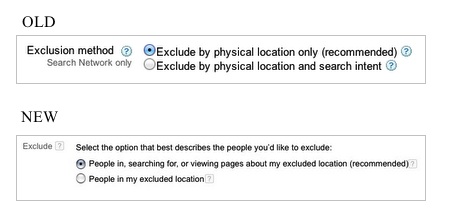Location Targeting Overhaul in Google

Google released multiple important changes to their location targeting this week. You should take note of them, as they’re good changes.
In a rapid fire set of blog posts (six minutes apart, Google? Are you trying to make us all look bad?), the Internet-leader of Internet Leading introduced the changes, which are below:
- The wording on your settings page is going to look different, while the content is almost the same. It went from highfalutin to more plainspoken. It honestly is a lot more digestible.
- Selecting the option “People in my targeted location” will now show ads to them regardless of their intent. This is especially big for travel marketers who want to advertise to people where they are, and not where they want to go.
- Location targeting has now extended itself to the Display Network. Not only is there a new tab for the DN, it now knows where your content is based (roughly). Soon, you can expect the Display Network to ride your carpool or sit next to you at lunch. It’s expanding and THERE’S NOTHING YOU CAN DO ABOUT IT. A side note to my by-now-completely-off-the-rails bullet point: the location targeting is similar to contextual targeting in that it gets a sense of where the content is located and shows ads accordingly. News items aren’t included in the new location targeting. You can also opt out of the new targeting by selecting “People in my targeted location” (but I’m guessing the Display Network would remember that and bring it up in some passive aggressive way later at dinner with you and the family).
- The language and default options for advanced location exclusions have changed (See below). While the language underwent the same transition from highfalutin to plainspoken, the important part here is that the default option changed. Now, “People in, searching for, or viewing pages about my excluded location” is the recommended option, which makes the default much more restrictive – so beware. This change only affects new campaigns, not existing ones.
So we’re already four oversized bullet points into this update and I think it’s time to take a break from them. Did you ever watch Seinfeld? Aside from my parents and my brother, it’s probably the biggest influence in my life. As an example, I only say “bless you” when people sneeze because of Seinfeld. And that’s just one example among hundreds. It’s really changed my life.
Now I’m a search marketer, and the battle for my soul is on. Google vs. Seinfeld. With Google’s second news post, they came into direct conflict. Everyone’s favorite mailman, Newman, has an opinion about zip codes: They’re meaningless. But Google disagrees. Onto more bullet points! (I’m assuming that your batteries are sufficiently recharged.)
- Campaigns can now be targeted by zip code in the US (apparently there are over 30,000 of them – who knew? {Newman. Newman knew.}) You can add up to 1,000 at a time and view results by zip as well. None of the old targeting options are going away, you just now have another option.
- Location extensions now have location insertion available. This is a really great feature for advertisers with locations in multiple cities. Now you won’t need specific ad text/campaigns for every city. Instead, just set up a location extension with location insertion included and enjoy all of that newfound free time. Mayhaps you can watch an episode of Seinfeld?
- These new location insertions run as a part of location extensions, so you need the extensions to be set up first. However, the insertion can show even if the location extension is bumped by another extension.
Two blog posts from Google warranted two sets of bullet points from PPC Hero. We have a lot of clients that are very interested in specificity of targeting, so I’m sure we’ll be giving the zip code option a try. Look for results at some point in the glorious, indefinite future, in which anything is possible.




